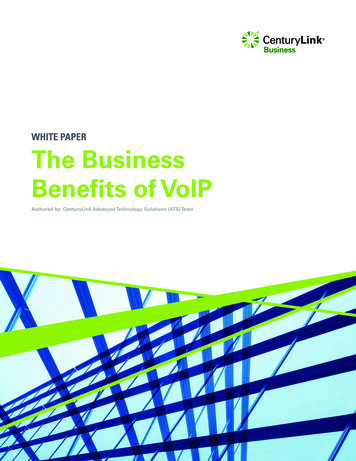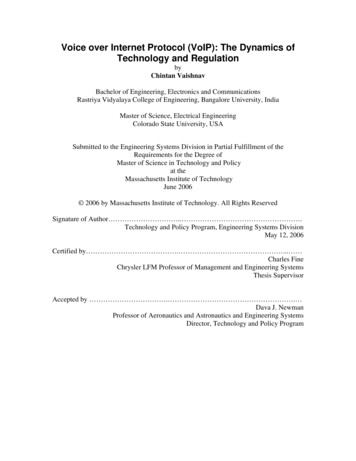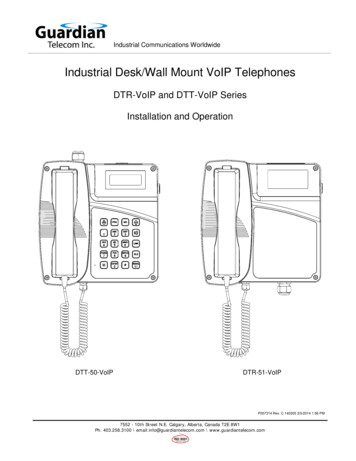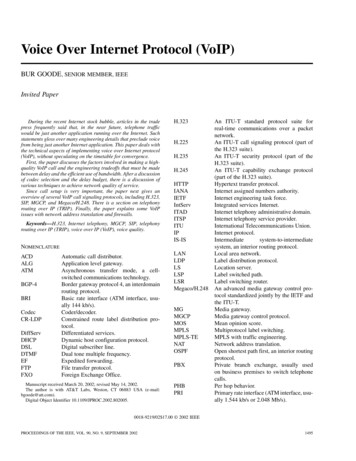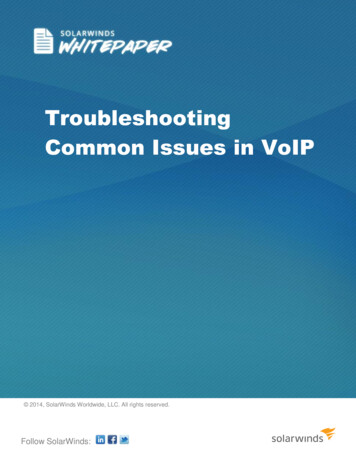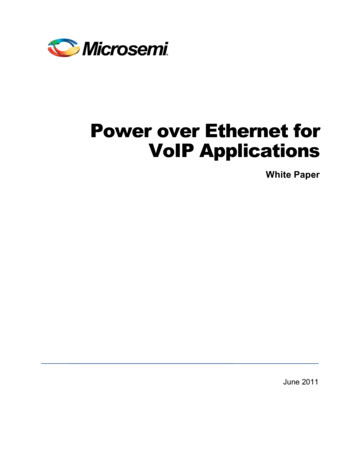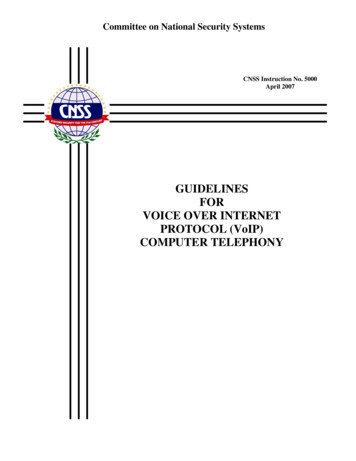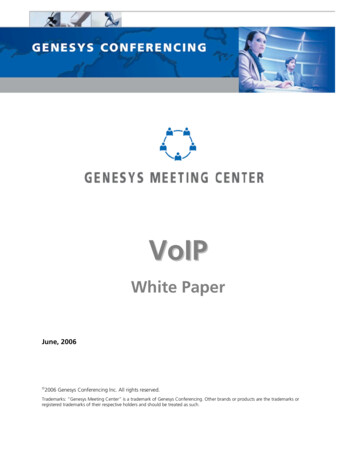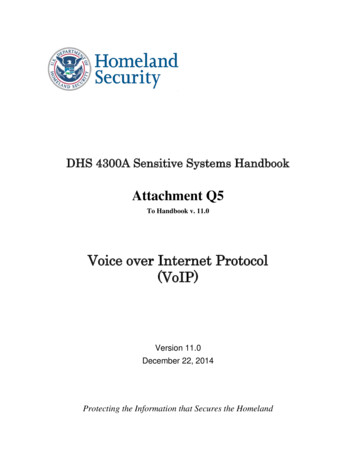
Transcription
DHS 4300A Sensitive Systems HandbookAttachment Q5To Handbook v. 11.0Voice over Internet Protocol(VoIP)Version 11.0December 22, 2014Protecting the Information that Secures the Homeland
DHS 4300A SENSITIVE SYSTEMS HANDBOOKATTACHMENT Q5 – VOICE OVER IPThis page intentionally blankV11.0, December 22, 2014ii
DHS 4300A SENSITIVE SYSTEMS HANDBOOKATTACHMENT Q5 – VOICE OVER IPDocument Change HistoryVersionDateHB version 11.0December 22, 2014V11.0, December 22, 2014DescriptionNew document.iii
DHS 4300A SENSITIVE SYSTEMS HANDBOOKATTACHMENT Q5 – VOICE OVER IPCONTENTS1.0INTRODUCTION . 11.1Purpose and Scope. 11.2VoIP Security Requirements Checklist. 12.0VoIP System Overview. 12.1VoIP System Architecture . 12.2Federal Guidance and Polices . 23.0THREAT OVERVIEW . 33.1 VoIP3.1.13.1.23.1.33.1.44.0Threats and Vulnerabilities . 3Eavesdropping. 3Network Vulnerabilities . 4Software Flaws and malware . 4Other Voice Service Related Threats . 4SECURING VoIP COMPONENTS . 44.1VoIP Security Mechanisms . 54.2Authentication . 54.3Virus Protection . 54.4Disabling Undesirable VoIP Features . 54.5Monitoring of System Configuration Change . 55.0SECURING VoIP Networks. 55.1Voice and Data Separation . 65.2Data Protection . 65.3Firewalls. 65.4URL . 65.5Logs. 65.6Configuration Control . 65.7Physical Security . 75.8Security Assessment . 75.9Security Incident Response . 76.0Communication Service Convergence – Unified Communications . 7V11.0, December 22, 2014iv
DHS 4300A SENSITIVE SYSTEMS HANDBOOKATTACHMENT Q5 – VOICE OVER IPAppendix A: Checklist for Securing VoIP Systems . 9Appendix B: Referenced Publications . 12Appendix C: Acronyms and Definitions . 13V11.0, December 22, 2014v
DHS 4300A SENSITIVE SYSTEMS HANDBOOKATTACHMENT Q5 – VOICE OVER IP1.0 INTRODUCTIONThis document provides techniques and procedures for the secure use of Voice over Internet Protocol(VoIP) within the Department of Homeland Security (DHS) Information Technology (IT) Program. Itis published as an Attachment to the DHS 4300A Sensitive Systems Handbook, which is based on DHSSensitive Systems Policy Directive 4300A.DHS Components should use the guidance in this Handbook Attachment as a foundation for developingand implementing VoIP IT related security programs. This Attachment incorporates many securitytechniques and procedures already in use by DHS Components and other Federal entities such as theNational Institute of Standards and Technology (NIST), the Department of Defense (DoD), andcommunication standardization organizations; and general VoIP security best practices commonlyrecommended and followed by private industry and academic communities.1.1Purpose and ScopeThe guidance outlined in this document is intended to address security policy requirements pertinent toVoIP, and to provide a detailed explanation of security threats and corresponding countermeasures thatcan be applied to VoIP systems deployed by DHS Components. The security checklist in Appendix Aprovides a summary of VoIP security guidelines.Authorizing Officials (AO) should understand the risks associated with each particular VoIP system, andapply some or all of the countermeasures outlined in this Attachment. They should ensure that each riskis measured and mitigated to an acceptable level according to DHS IT security policies defined by theDHS Sensitive Systems Policy Directive 4300A and other related directives.1.2 VoIP Security Requirements ChecklistUse the Security Requirements Checklist for VoIP Systems, Appendix A to this document, to ensureComponent compliance with Policy Directive 4300A and with underlying Government directives. TheChecklist items identified as “Required” must be implemented by Component policies, SOPs, or othermethodological documents; furthermore, implementation of the items identified as “Recommended” orequivalent provisions, will ensure that Components are compliant with best security practices.2.0 VOIP SYSTEM OVERVIEWThis section gives a brief introduction of VoIP system architecture and technologies in an enterpriseenvironment, and provides a high-level summary of Federal guidance and policies for VoIP systems.2.1VoIP System ArchitectureVoIP is a technology that converts voice into digital data packets that are transmitted over IP datanetworks such as enterprise networks or the Internet. VoIP is a mature technology that has been widelydeployed across public and private sectors since it uses existing IP data network infrastructure,V11.0, December 22, 20141
DHS 4300A SENSITIVE SYSTEMS HANDBOOKATTACHMENT Q5 – VOICE OVER IPeliminating expensive traditional dedicated voice circuits. The following diagram describes typicalenterprise VoIP system architecture and key system components.Figure 1: Enterprise VoIP System Architecture.The VoIP server is the control and management hub of all VoIP components. It is responsible for VoIPcall session management, voice mail management, directory assistance, and other additional servicessuch as conference bridge.The gateway is connected to telephone service providers’ Public Switched Telephone Networks (PSTN),and is the bridge between the internal VoIP system and general PSTN: all calls to or from outsidetelephone numbers go through the gateway.In addition to VoIP telephone instrument hardware, VoIP softphones are widely deployed. A VoIPsoftphone is a computer program that runs on desktop or laptop computers, mobile devices etc., allowingusers to make VoIP calls through those devices.2.2Federal Guidance and PolicesThe U.S. Federal Communications Commission (FCC) requires VoIP systems to support enhanced 911(E911) emergency services that provide caller identification and location information to the answeringPublic Safety Answering Point (PSAP).NIST Special Publication 800-58, "Security Considerations for Voice over IP Systems,” providesagencies with guidance for establishing secure VoIP networks and makes several recommendations toestablish a secure VoIP and data network. Key recommendations are as follows:V11.0, December 22, 20142
DHS 4300A SENSITIVE SYSTEMS HANDBOOK ATTACHMENT Q5 – VOICE OVER IPDevelop appropriate network architecture.Ensure that the organization has examined and can acceptably manage and mitigate the risksto their information, system operations, and continuity of essential operations whendeploying VoIP systems.Carefully consider such issues as level of knowledge and training in the technology; maturityand quality of security practices; controls, policies, and architectures; and understanding ofassociated security risks.Be aware that physical controls are especially important in a VoIP environment and deploythem accordingly.Enable, use, and routinely test the security features that are included in VoIP systems.Deploy VoIP-ready firewalls and other appropriate protection mechanisms.If mobile units are to be integrated with the VoIP system, use products that implement Wi-FiProtected Access (WPA), rather than Wired Equivalent Privacy (WEP).Carefully review statutory requirements regarding privacy and record retention withcompetent legal advisors.3.0 THREAT OVERVIEWThis section discusses VoIP threats and vulnerabilities in an enterprise environment, and outlinescorresponding countermeasures and security best practices.3.1VoIP Threats and VulnerabilitiesVoIP systems are vulnerable to specifically engineered attacks as well as to general network attacks.VoIP is fundamentally different from the traditional circuit-based telephony, and these differencesintroduce significant security threats and vulnerabilities.A VoIP system is part of the overall enterprise IT infrastructure and is directly connected to theenterprise core IP network. Therefore strict security controls and governance must be developed andenforced by Components to mitigate constant and ever- increasing threats to DHS IT infrastructure andresources.3.1.1EavesdroppingEavesdropping describes the threat whereby an attacker secretly captures data. Eavesdropping onconventional telephone transmissions requires physical access to tap a telephone line or Private BranchExchange (PBX). With VoIP, the eavesdropping attack surface increases dramatically: besidestelephone lines and PBX, any network node or line can be tapped to capture the VoIP data (and therebythe phone conversation). Many packet capture tools (also known as packet analyzers) are readilyavailable, often free from open sources that can be easily deployed to record VoIP conversations.Eavesdropping risk can be mitigated by using data encryption validated by Federal InformationProcessing Standard (FIPS) 140-2, mandated by the Government, for all sensitive data communicationswithin the data network. Mobile users are required by their Rules of Behavior to use the DHS VirtualPrivate Network (VPN) service for remote access from locations not controlled by DHS.A robust network and physical security will also help to mitigate the risk. Network firewalls, IntrusionDetection Systems (IDS), and Intrusion Prevention Systems (IPS) can be used to filter data traffic,V11.0, December 22, 20143
DHS 4300A SENSITIVE SYSTEMS HANDBOOKATTACHMENT Q5 – VOICE OVER IPmonitor the network infrastructure, detect and block abnormal network traffic, and send notifications toadministrators if unusual events occur. Unused network access ports should be shut down and only beactivated by authorized network administrators.3.1.2Network VulnerabilitiesSince VoIP systems are part of the overall enterprise IP network infrastructure, they will face similarnetwork attack vectors.A Distributed Denial of Service (DDoS) attack on the network occurs when an attacker floods thenetwork with bogus data packets, preventing or inhibiting legitimate users from accessing the network.In addition, VoIP data is often prioritized over other data traffic by DDoS attacks since VoIP systemsmust meet a strict set of network performance requirements such as short latency and low packet lossrates. Therefore, a lot of network resources serve VoIP systems at high priority. A well-crafted DDoSattack on VoIP systems will not only severely affect voice service, but will also impair other criticalnetwork activities and services.To counter DDoS attacks, Components must implement a comprehensive defense-in-depth securitystrategy to secure their networks. A robust IT security system must be implemented that includesfirewalls, IDS, IPS, and VoIP-aware network monitoring and management systems.3.1.3Software Flaws and malwareVoIP systems have many software components. The key VoIP component, the VoIP server, is oftenbuilt upon commercial operating system platforms (for example, Microsoft Windows or Linux systems).Computer-based softphones will be exposed to all kind of malware including key-loggers, Trojanhorses, and others) currently experienced by end users. As a result, VoIP systems inevitably will beexposed to software flaws and potential attacks from various malware.Regular checking for software updates and patches is essential to reduce these vulnerabilities.Automated patch handling can help in reducing the window of opportunity for intruders to exploit aknown software vulnerability. Standardized enterprise anti-virus tools and VoIP-related softwaresecurity management systems can also greatly mitigate software threats.3.1.4Other Voice Service Related ThreatsOther threats to VoIP systems are similar to those to traditional telephony, such as unauthorized voicedevices and endpoints attempting to connect to the system, voicemail tampering, caller ID spoofing, tollfraud, etc. Toll fraud, for example is a phone hacking scheme where a compromised VoIP system iscontrolled by external attackers to route long distance or international calls through enterprise networks.This can result in substantial financial loss and legal liabilities for VoIP system owners.Existing security measures, such as requiring strong voice passwords, security awareness training,robust logging and monitoring mechanisms, and in-depth network security are some of the effectivecountermeasures to protect against these threats.4.0 SECURING VOIP COMPONENTSA VoIP system should be considered to be a critical component of the DHS network and an extension ofthe DHS IP network infrastructure. Critical tasks associated with securing the system includeV11.0, December 22, 20144
DHS 4300A SENSITIVE SYSTEMS HANDBOOKATTACHMENT Q5 – VOICE OVER IPauthentication, virus protection, configuration management, continuous monitoring, and disablingunused features.4.1VoIP Security MechanismsVoIP systems support a whole set of security mechanisms either specified by or used by VoIP protocolsto protect the VoIP signaling and voice data messages. Secure Session Initiation Protocol (SIP) is asecurity mechanism that protects VoIP signaling messages over an Internet Protocol Security (IPsec) orTransport Layer Security (TLS) encrypted channel. The Secure Real-time Transport Protocol (SRTP)provides encryption, message authentication and integrity for voice messages over the communicationpath.4.2 AuthenticationIdentification management and authentication will be implemented to access the VoIP system.4.3Virus ProtectionStandard anti-virus software tools, -regular software updates and patches are essential to reduce softwarevulnerabilities to the VoIP system.4.4Disabling Undesirable VoIP FeaturesVoIP systems provide a rich set of features such as video teleconferencing. If some features are notbeing used but left in default unprotected configuration, they become vulnerabilities that an attacker canexploit to access the VoIP system and the network infrastructure. Components should carefully evaluatethe business and operations requirements for their VoIP services and only enable the VoIP featuresrequired. For example, unprotected File Transfer Protocol (FTP) and Trivial FTP (TFTP) are oftenenabled by default by some VoIP systems between the VoIP server and the end-user devices forconfiguration management. These features should be disabled or replaced by secured ones such asSecure File Transfer Protocol (SFTP) that provide similar functionality.4.5Monitoring of System Configuration ChangeInformation Systems Security Officers (ISSO) should implement mechanisms that periodically scan forunauthorized changes to VoIP system configurations.5.0 SECURING VOIP NETWORKSVoIP systems are part of overall enterprise IP network infrastructure, and they introduce a number ofnew elements, complications and challenges to existing network management and security. Theintegration of voice and data in a single network is a complex process that requires greater effort thanthat required for data-only networks. Critical risks that must considered when securing VoIP networksinclude voice and data separation, data protection, operation management, physical security, securityassessment, and incident response.V11.0, December 22, 20145
DHS 4300A SENSITIVE SYSTEMS HANDBOOK5.1ATTACHMENT Q5 – VOICE OVER IPVoice and Data SeparationAlthough voice and data share the same network infrastructure, they should be logically or physicallyseparated into two segments in order to apply different security measures (for example, different firewallrules) to reduce the likelihood of an attacker using one segment to access the other. Other benefits ofseparation include easier network management and troubleshooting. Separation makes attacker successmore difficult and helps to provide a layered approach to VoIP and network security.5.2Data ProtectionData protection security means that messages are encrypted between sending device and receivingdevice. VoIP telephone instruments and softphones can support encryption capabilities, and datatraversing the enterprise’s backbone network is also protected by FIPS 140-2 validated encryption. Inaddition, TLS, IPSec, VPN, and Secure Shell (SSH) are common means of providing end-to-endencryption for VoIP administrators when remotely accessing the VoIP systems.5.3FirewallsA firewall helps to secure the network by inspecting inbound and outbound network traffic and onlyallowing pre-defined data traffic. Protocols for VoIP systems specify the traffic type that is used forvoice service. For example, the Session Initiation Protocol (SIP), a VoIP signaling communicationsprotocol, requires SIP clients to use Transmission Control Protocol (TCP) or User Datagram Protocol(UDP) on port numbers 5060 or 5061 to connect to SIP servers and other SIP endpoints. Any signalingattempt via other port numbers should be blocked by firewalls.5.4URLIn some cases a VoIP endpoint will be configured with one or more Uniform Resource Locators (URLs)pointing to the locations of various servers with which they are associated such as their call controller.The use of URLs in this manner permits an endpoint to find the server it is looking for in the event theserver’s IP address is changed. This also permits the endpoint to locate its assigned or home callcontroller from a remote location on a network that is not their home network. While use of URLs addsflexibility to the system and to endpoint location, it also exposes the endpoint and the home system toDNS vulnerabilities.5.5 LogsLogs serve as part of the VoIP monitoring and management capabilities to ensure that VoIP systems areconstantly monitored. They provide a traceable mechanism for recording communication activities andthey reveal network intrusions. Access to logs should be strictly controlled to ensure their integrity.5.6Configuration ControlEstablishing configuration requirements and baseline configurations for VoIP systems can help ensurethat they are deployed in a secure manner in accordance with DHS security policies.VoIP systems are usually initially configured with default vendor settings that are common knowledge.These settings can include network information such as default channels; modulation specifications;V11.0, December 22, 20146
DHS 4300A SENSITIVE SYSTEMS HANDBOOKATTACHMENT Q5 – VOICE OVER IPsecurity information such as network name, encryption methods, pass phrases or keys; and systemsmanagement information such as administration usernames, passwords, management port numbers, anddefault application services running.5.7Physical SecurityRoutine inspections and surveillance to detect suspicious behavior will reduce the likelihood ofunauthorized equipment tampering and theft. Because VoIP end user equipment is susceptible tophysical tampering, users should report any suspicious individuals or activities to appropriate securitypersonnel.5.8Security AssessmentRegular security assessments should be performed to evaluate the security posture of VoIP systems andto determine corrective actions needed to ensure that the systems remain secure. Regular assessmentshelp to determine whether VoIP systems are communicating correctly and are on correct channels.Assessments can also help Components determine whether controls are appropriately designed andoperating effectively to achieve organizational control objectives. The DHS 4300A Sensitive SystemsHandbook describes assessment areas and procedures in great detail.5.9Security Incident ResponseMost security controls are designed to protect an organization against security threats; regardless of howeffective those controls are, some security incidents are inevitable, and organizations need to have aneffective response capability in place before they occur. DHS 4300A Sensitive Systems Handbook,Attachment F, “Incident Response” covers incident response in detail6.0 COMMUNICATION SERVICE CONVERGENCE – UNIFIED COMMUNICATIONSThe convergence of voice, video, and data services, also referred as Unified Communications (UC), hasbeen gaining popularity in both public and private sectors. UC integrates voice, video, teleconferencing,messaging, email, and other enterprise applications to meet the critical and ever-increasing demand foran efficient and effective enterprise communications service.Unlike isolated traditional voice or video systems, the UC presents an attack surface and associatedvulnerabilities that have increased substantially; threats can originate from many sources: network,individual communication system, Web, the array of end-user devices, social engineering, etc. UC’sintegration brings greater complexity to system architecture. In addition, UC systems must addressincreased regulatory requirements for privacy, confidentiality, and other Government mandates such asE911 and the Health Insurance Portability and Accountability Act (HIPAA). All these factors increasethe difficulty of securing UC systems.Conventional network security measures, such as a firewall at the network boundary, help to mitigateUC risks, but are not adequate, since they are neither designed to protect UC-specific attacks nor arethey aware of the complicated interaction among different UC components, and do not provide anintegrated security capability for voice, video and other communication channels. An integratedsecurity mechanism for UC is required to protect network, communication system, enterprise applicationV11.0, December 22, 20147
DHS 4300A SENSITIVE SYSTEMS HANDBOOKATTACHMENT Q5 – VOICE OVER IPand data, and end-user device in a seamless fashion. In addition, the new UC security mechanism needsto work in conjunction with existing network security measures to provide layered protection of UCsystems.V11.0, December 22, 20148
DHS 4300A SENSITIVE SYSTEMS HANDBOOKATTACHMENT Q5 – VOICE OVER IPAPPENDIX A: CHECKLIST FOR SECURING VOIP SYSTEMSSECURITY REQUIREMENTS CHECKLIST FOR VOIP SYSTEMSSECTION 4.0: SECURING VOIP COMPONENTS Section 4.1: VoIP Security MechanismsRequiredThe Secure Session Initiation Protocol and Secure Real-time Transport Protocol areenabled to protect the VoIP systems.XFrom locations not physically controlled by DHS, users access DHS systems only via theDHS Virtual Private Network (VPN) serviceX Section 4.2: AuthenticationRequiredNo password is required to access the end user VoIP phone sets.Passwords used by administrators to access key VoIP system components follow thepassword strength guidance given in DHS 4300A Sensitive Systems Handbook Section5.1.1.1, “Selecting Strong Passwords.” Section 4.3: Virus ProtectionX Section 4.4: Disabling Undesirable VoIP FeaturesUnapproved or unnecessary VoIP features are disabled or removed whenever possible.X Section 4.5: Monitoring of System Configuration ChangeIntegrity verification mechanisms are deployed to perform system configuration integritychecks automatically, by means such as routinely comparing a cryptographic hash of thecurrent system configuration files to a previously recorded hash known to be valid.V11.0, December 22, ated capabilities such as cameras and recording mechanisms are subject tothe approval of the AO. These capabilities have varying degrees of risk and are disabledunless specifically required, in order to mitigate the risk of exposing sensitive informationEnd user VoIP telephone sets issued by Components are distributed and restricted to anapproved baseline configuration.XXRequiredAnti-virus software is deployed, centrally managed, and continuously updated on VoIPsystems.RecommendedXPasswords to access key VoIP system components by administrators are combined withthe use of a smart card or a biometrics authentication method.Numerical passwords used for the VoIP voicemail access contain a minimum of eightdigits, or the maximum allowed by the system is used if the device’s maximum is lessthan eight.RecommendedXXRequiredRecommendedX
DHS 4300A SENSITIVE SYSTEMS HANDBOOKATTACHMENT Q5 – VOICE OVER IPSECURITY REQUIREMENTS CHECKLIST FOR VOIP SYSTEMSSECTION 5.0: SECURING THE VOIP NETWORKS Section 5.1: Voice and Data SeparationRequiredVoice and data are logically or physically separated across the enterprise network.Common traffic separation techniques include IPSec tunnels or Virtual Local AreaNetwork (VLAN) separation mechanisms.XA different, dedicated, IP address block or range is defined for the VoIP system that isseparate from the IP address blocks/ranges used by the rest of the data network.XRecommendedIf the VoIP system design uses Dynamic Host Configuration Protocol (DHCP) for VoIPinitial endpoint address assignment or configuration, a different and dedicated DHCPserver is used than that used for data components and hosts.XIn the event Domain Name System (DNS) is used in the VoIP system, a different anddedicated DNS server is used and any VoIP DNS server interaction with other DNSservers is limited.X Section 5.2: Data ProtectionRequiredVoIP data traversing the DHS backbone network is encrypted with the FIPS 140-2validated Advanced Encryption Standard [AES]-256 encryptionto protect the confidentiality of data.XRemote access to the VoIP system uses FIPS 140-2 validated AES-256 encryption toensure secure access.X Section 5.3: FirewallsRequiredFirewalls for VoIP systems allow only the pre-defined VoIP traffic and block all othertraffic. Section 5.4: URLRecommendedXRequiredVoIP endpoint limits the use of URLs.RecommendedX Section 5.5: LogsRequiredVoIP systems are configured to create logs and capture important events such assuccessful and unsuccessful administrator login attempts, user attempts, device MAC andIP addresses, access violations, ports and protocols used, and application activities.XVoIP log entries are captured, analyzed, and correlated by a centralized log managementsystem.X Section 5.6: Configuration ControlRequiredConfiguration requirements and baselines
This document provides techniques and procedures for the secure use of Voice over Internet Protocol (VoIP) within the Department of Homeland Security (DHS) Information Technology (IT) Program. It is published as an Attachment to the DHS 4300A Sensitive Systems Handbook, which is based on DHS Sensitive Systems Policy Directive 4300A.
